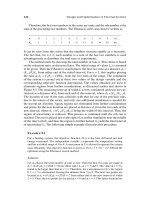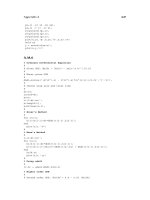lecture on safety and security of information systems lesson 3 cryptography 728
Bạn đang xem bản rút gọn của tài liệu. Xem và tải ngay bản đầy đủ của tài liệu tại đây (1.22 MB, 56 trang )
Cryptography
Contents
1)
Basic Terminology of cryptography
2)
History of cryptography
3)
Symmetric Cipher
4)
Asymmetric Cipher
5)
Hashing algorithms
1. Basic Terminology
Basic Terminology
Plaintext: The original message
Ciphertext: the crypted message
Encryption: the process of converting plaintext into ciphertext
Plaintext
Ciphertext
Decryption: the process of recovering ciphertext into plaintext
Ciphertext
Plaintext
Cipher: is an algorithm to encrypt or decrypt information.
Basic Terminology
Cryptosystem: The algorithms, or ciphers, used to encrypt and decrypt
data
Cryptosystem = encryption + decryption algorithms.
Key:
info used in cipher known only to sender/receiver
Cryptology
Cryptography: is the Science of Writing in Secret Code
Cryptanalysis: science of studying attacks against cryptographic systems
Cryptology = Cryptography + Cryptanalysis
CRYPTOLOGY
CRYPTOGRAPHY
CRYPTANALYSIS
Cryptography
Cryptographic systems are characterized along three independent dimensions
Type of encryption operations used
Substitution: replacing each element of the plaintext with another element
Transposition: rearranging the order of the elements of the plaintext.
Product: using multiple stages of substitutions and transpositions
Cryptography
Number of keys used:
Symmetric: single-key, private-key
Asymmetric: two-key, public-key
way in which the plaintext is processed
Block cipher: processes the input one block of elements at a time
Stream cipher: processes the input elements continuously
Cryptanalysis
Objective: to recover the key in use rather than simply to recover the
plaintext of a single ciphertext.
Two general approaches:
Brute-force attack: try every key to decipher the ciphertext
Cryptanalysis attack: exploit the characteristics of the algorithm to attempt to
deduce a specific plaintext or to deduce the key being used
Cryptanalysis
Brute-force attack: On average, half of all possible keys must be tried to
achieve success.
Cryptology
CRYPTOLOGY
CRYPTOGRAPHY
SYMMETRIC
CLASSICAL
MODERN
Substitution
Block ciphers
Transposition
Stream ciphers
ASYMMETRIC
CRYPTANALYSIS
2. Symmetric Ciphers
A. Classical Encryption
B. Modern Encryption
SYMMETRIC CIPHER MODEL
Plaintext
Encryption algorithm
Secret key
Ciphertext
Decryption algorithm
Requirements
Two requirements for secure use of symmetric encryption:
strong encryption algorithm
secret key know only to sender/receiver
Mathematically have
Y=E(K,X)
X=D(K,Y)
assume encryption algorithm is known
implies a secure channel to distribute key
A. Classical encryption
Caesar Cipher
Monoalphabetic Ciphers
Playfair Cipher
Hill Cipher
Polyalphabetic Ciphers
One-Time Pad
Substitution Techniques
A. Classical encryption (Cont.)
Transposition Techniques
Steganography
Substitution Techniques
a) Caesar Cipher
Invented by Julius Caesar.
Each letter is replaced by the letter K positions further down the alphabet.
Example:
Plaintext: meet me after the toga party
Key: k=3
Ciphertext: PHHW PH DIWHU WKH WRJD SDUWB
a) Caesar Cipher
Mathematically, map letter to numbers:
C = E(P, k) = (P + k) mod 26
P = D(C, k) = (C - k) mod 26
C: Ciphertext letter
P: Plaintext letter
K: Key [1-25]
Plaintext = “Go to the canteen after class”, k =4
Ciphertext = ???
Cryptanalysis of Caesar Cipher
Key space: {1, …, 25}
Vulnerable to brute-force attacks
Example: Break ciphertext “UNOU YZGZK”
b) Monoalphabetic Cipher
A permutation of a finite set of elements is an ordered sequence of all the
elements of , with each element appearing exactly once.
For example, if S={a,b,c}, there are six permutations of S:
abc, acb, bac, bca, cab, cba
There are n! permutations of a set of n elements
Substitution characters are a random permutation of the 26 letters of the
alphabet
Monoalphabetic Cipher
Plaintext: “meet me after the toga party”
Ciphertext: ???
Monoalphabetic Cipher Security
26! Key
It is secure against brute-force attacks.
But not secure against some cryptanalytic attacks
Problem is language characteristics.
Relative Frequency of Letters in English Text









